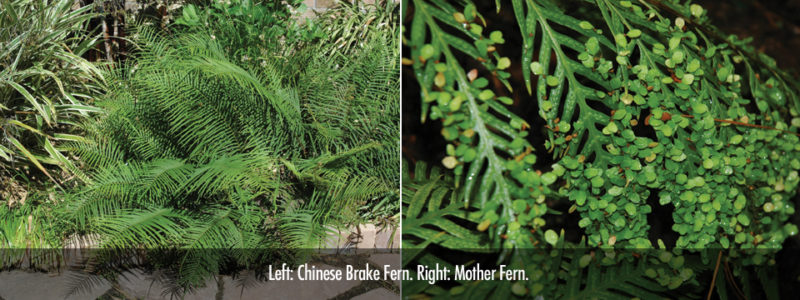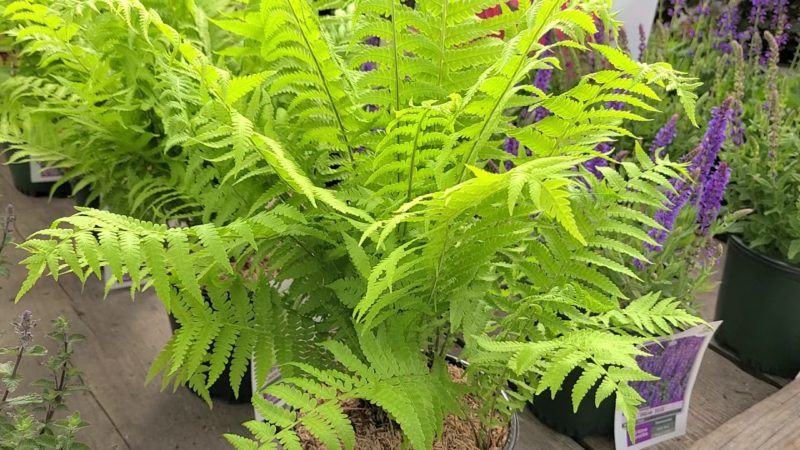Ferns in Texas
Contents
Ferns are the one plant that everyone knows, but knowing the individual species gets a little trickier. Use this quick and easy fern primer to help you choose ferns for sunny or shady spots in your garden, in addition to ferns that work well inside the home.
SUN-LOVING FERNS
SUN-LOVING FERNS can take direct sun for about 4 hours per day (morning, mid or afternoon) and then filtered rays the rest of the day. These ferns thrive on LESS water, which makes them easily adaptable to sunny locations. NOTE: Overwatering or not allowing the soil to dry out in between watering causes roots to rot quickly followed by death.
Chinese Brake
SUN 1) Chinese Brake (Pteris vittata) is the toughest sun fern, will grow in rocky soil and in FULL sun or in soil with minimal water. Now if you put this fern in the shade and watered daily, you would probably kill it. This fern is also being used to remediate arsenic laced soils. I love this fern; it has a clumping habit and can spore onto rocks and bricks if growing in a moist, part-shaded location.

Australian Sword Fern
SUN 2) Australian Sword Fern (Nephrolepis cordifolia) is another bullet-proof fern with many uses. A spreading fern, it travels using surface foraging roots to climb a palm or tree, or up a wall of fig ivy. It can cascade outside the fig ivy creating a grotto effect, or in a container. It resembles a Boston fern but does not shed like one. Grow it in full sun to half day of shade. This drought-tolerant plant has round storage tubers on the roots acting as water and nutrient reservoirs.
Lace Fern
SUN 3) Lace Fern (Microlepia strigosa) is a tight, clumping fern with shiny leaflets that grows to 24-30 inches tall. It is a great accent fern that reflects sunlight when kissed by the sun. Plant declines in deep shade.
Silver Ribbon
SUN 4) Silver Ribbon (Pteris cretica ‘Albo-lineata’) is one of my favorite ferns, and I use it in flower beds and in containers. Fertile fronds give the fern 16-18 inches of height. Remove fronds when they turn brown. This beautiful variegated fern is about 10-12” inches tall. Use a bark base potting soil for this fern.
Mother Fern
SUN 5) Mother Fern (Woodwardia orientalis) is the largest of the group, growing 4-6 feet tall by 6-foot wide, and creates a wonderful architectural form for the garden. It prroduces baby plantlets on the mature frond, hence mother fern. Plant ajuga or begonias around the crown of the plant to fill in the empty space created by the long arching fronds.
SHADE-LOVING FERNS
SHADE-LOVING FERNS grow on the forest or jungle floor with lots of humidity and get little or no sunlight.
Maidenhair fern
SHADE 1) Maidenhair ferns of all varieties love deep shade with lots of moisture, but the soil must be more alkaline (higher ph.) than acidic, and you can accomplish this by adding crushed limestone and mixing it into the soil.
Felt Fern
SHADE 2) Felt Fern (Pyrrosia hastata) is one of the newer fern introductions, and I view it as really quite hardy. This fern will wilt when thirsty where most ferns just shed older leaves. The leaves feel like fabric and have an unusual spear-head shape. This fern works also works well indoors.
Dwarf Hawaiian Tree Fern
SHADE 3) Dwarf Hawaiian Tree Fern (Blechnum gibbeum) is a lovely miniature tree fern. It grows quite quickly, so plant away from the north wind and frost. The geometrically arranged fronds make this architectural beauty a must for any garden.
HOUSE FERNS need to be adaptable to lower light and lower humidity. Use your ferns near brightly lit windows in rooms with higher humidity, such as kitchen and bath. Be wary of placing it in a small kitchen for cooking — residue can coat leaves, reducing the amount of light transmission to the plant.
Tips on Growing Ferns Inside: Use a peat-based potting soil and plant in a plastic container to keep soil from drying out. Do not plant ferns in claypots as they are porous and pull 50 percent of the water away from the plant.
BEST FERNS FOR INDOORS
Austral Gem
Austral Gem (Asplenium hybrid) has beautiful dark green foliage and stems with a glossy shine that is tough and great looking and tolerates a drier soil and lower humidity. A very nice and easy fern.
Santa Rosa Fern
The Santa Rosa Fern (Aglaomorpha) has upright fronds with a fuzzy foot and best grows as a hanging fern mounted on a wooden board with sphagnum peat moss in bright light.
Rabbit’s foot fern
Rabbit’s foot fern (Davallia) is a hanging fern that crawls around the top and side of the pot with brown and white furry feet. Grow in bright light and mist daily with a spray bottle.
Button Fern (Pellaea rotundifolia) is a native to New Zealand and has shiny dark green round leaves with a red stem that get 6-10 inches tall. Grow in bright light and allow the top of the soil to dry out before watering.
‘Lemon Button’ (Nephrolepis cordifolia) has the smallest round leaves, grows upright and is drought tolerant. This fern doesn’t shed, great indoors or outside.
Birdnest Fern
Birdnest Fern (Asplenium) has tall, wide, erect fronds growing from a central crown. During transplanting do not bury the crown, as this will kill the plant. Other hybrids are shorter with unique fronds: Victoria’ has wavy fronds; and ‘Crissie’ is shorter with forked fronds that look crested. Grow in bright light, water when top half of the soil is dry, and use a plastic pot.
So the next time you see a fern, stop, take a closer look to see just how interesting and different they really are.

